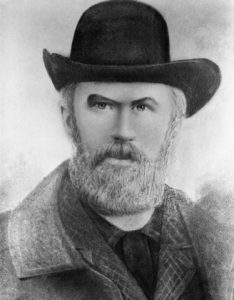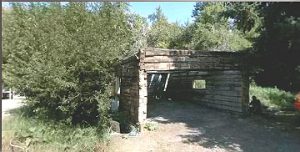GLENN, John (1833-1886)
John Glenn
Calgary’s first European Settler

John Glenn
Born: 1833 at County Mayo, Ireland
Married: 1 Sept 1873 at St. Anne, N.W.T. to Adelaide Belcourt
Died: 9 Jan 1886 (age 53) at Calgary, Alberta
Buried: St. Mary’s Pioneer Cemetery, Calgary, Alberta, plot 08:D:05
Contributor: Jim Benedict
John’s Early Years
John was born and raised in County Mayo, Ireland. Restless as a young lad, he first tried moving to England, but changed his mind and returned home. Later in 1849 at age 16, he immigrated to the United States and travelled to Waco Texas, to work on a ranch. Later, at age 28, he was drafted into the Confederate Army, later deserting as he did not believe in slavery. Joining the other side, John served under Union General Sherman until the end of the civil war, in 1865.
After travelling around the United States, working in mines, John headed north to British Columbia, and to Bakerville, B.C., panning for gold, where he met his future Alberta neighbours, James Votier and Sam Livingston.
John and Adelaide

Adelaide Belcourt Glenn 1880
Adelaide Belcourt was the Metis wife of John Glenn. She was from Lac Ste. Anne, N.W.T.. They were married on September 1, 1873 in St. Anne at the local mission.
With two horses and a mule, John and Adelaide headed south to find suitable farming land. Impressed by the fertile soil in the Bow Valley area, they settled on a plot where the Fish Creek waters merge with the Bow River. They built a log cabin complete with sod roof, stone fireplace and chimney, in the winter of 1873, becoming the first settlers in the Calgary (Midnapore) area. Later on, John said, “I like the climate better than any I have found between the Atlantic and the Pacific; the Rio Grande and the Peace, over all of which territory I have travelled. There is everything in the country a settler can desire.”1
Adelaide had eight children, two died in infancy), tending livestock, running a boarding house with her husband for travelers, and providing emotional support to the early women settlers who arrived shortly after her pioneering settlement. Her services as a midwife earner the nickname of the “Grandmother of Midnapore.”
The Children
- Patrick Glenn
- John Glenn
- Alfred Glenn
- William Glenn
- Edward Glenn
- Margaret Glenn
- Eliza Glenn (died in childhood)
- Mathilde Glenn (died in childhood)
As there were no schools in the area, the first two children were sent to Winnipeg to be educated at St. Boniface school. The other five went to James Short school and later, to St. Mary’s school.
Patrick was the only child to marry. His wife as Filomena Hodgson, daughter of George Hodgson, Indian Agent at Sarcee Indian Reserve.
Moving up creek

Remains of John Glenn’s original cabin
In the mid 1870’s, the main trading supply place was the I. G. Barker Company, headquartered in Fort Benton, Montana. In 1874, John and Adelaide and new-born Patrick headed south to Fort Benton, to sell his furs and to buy another team of four horses and harness and a wagon. Turning around and heading back north to Fish Creek, loaded with various provisions for sale to the Indians, they ran into the N.W.M.P. under the command of Colonel Macleod, and guided them to the future location of Fort Macleod. The police bought all of John Glenn’s provisions.
When the N.W.M.P. arrived in the future location of Calgary, John helped to build the Fort as well as all the stone chimneys and fireplaces. He then travelled again to Fort Benton, returning with materials to build a new, permanent home. Over the next three years, John built a large dwelling, barn and other buildings, which became an established stopping place for travellers on the Macleod Trail.
The federal government now needed an Indian Supply Farm in the area, and John’s farm looked like the ideal location, being fertile and at the junction of a creek and the Bow River. Edgar Dewdney, Commissioner of Indian Affairs, made an offer of $360 for the land, development, one cow and one calf. On August 1, 1879, the land changed hands.
John moved up the Fish Creek to an area on Fish Creek, within site of the present Macleod Trail. He started the first irrigation project in Alberta. Part of the irrigation waters supplied the woolen mills operated by the Shaw family.
Town of Calgary
Calgary started as Fort Calgary, named by Col. James Macleod, after his Scotland roots. John expanded his farm holdings to 200 acres fenced in, 90 acres farmed and a large house, outbuildings, stable and store house. As the CPR started to sell land in the new Calgary, John purchased the first plot. By 1884 he had three building under construction. He then erected the largest livery stable and two of the largest business buildings.
Final Years for John Glenn
In late 1885, John was thrown from his wagon, likely when the horses were spooked, resulting in injury. He never fully recovered and died of pneumonia on January 9, 1886.
- John Glenn website: http://www.johnglenn.ca/ [↩]
